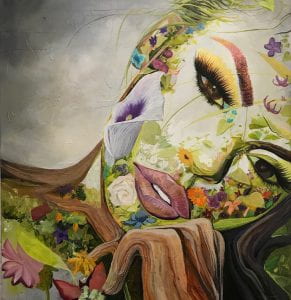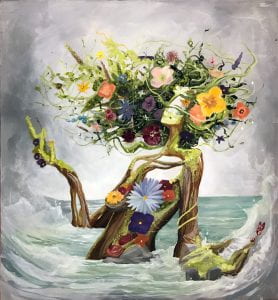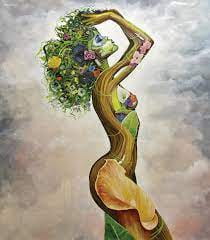I can hear her voice in the wind
Watching as it dances with the trees
I can feel her tears as the river flows around me
Calling, pulling me towards her
The Earth is calling me home
Ashes to ashes, dust to dust
The poem above is something I wrote a few months ago. I was pondering the different aspects of life and the cyclical nature of all of its aspects. Born of the Earth, she will eventually call us back to the dirt. The science side of things explains that the Earth gave us the nourishment we need and in death we will do the same for the Earth. And it got me thinking about how all things in life are interconnected, which leads to this week’s topic of intersectionality.
As humans, we often fail to see the smaller scale of this connectivity, as we are more consumed with the social aspects of our lives, but there is a deeper connection there with the philosophy of intersectionality. Coined by Kimberlé Crenshaw, intersectionality “illuminate[s] the interconnectedness of race, class, gender, disability, sexuality, caste, religion, age and the effects which these can have… on the discrimination, oppression, and identity of women and the natural environment” (Kings).

Through the course of this semester, we have spent time looking at most of these aspects on a smaller scale. From the Grassroots movement in the Global South to deeper philosophical aspects of vegetarianism and the suppressed female voice in government, all of these things have a connection through the lens of ecofeminism. “Ecofeminism exposes the repression of women and the environment as interlinked and rooted in patriarchal structures”, as defined by Leah Thomas in her article, The Difference Between Ecofeminism & Intersectional Environmentalism. Thomas also defines intersectional environmentalism as “an inclusive version of environmentalism that advocates for the protection of people and the planet and addresses how the injustices happening to marginalized communities and the earth are interconnected”.
These are both very similar ideas, the difference being that ecofeminism focuses more on the patriarchal influence over the feminine interconnectedness to the environment. It does not discredit intersectional environmentalism, but more so takes what it known and examines it from a more feminist perspective. The important commonality between both philosophies, is their understanding of the ecology and our human connection to it.

Ecology, in the simplest of terms, is the study of the relationships between organisms and their environment. Marine biologist and conservationist, Rachel Carson spent her life writing about the environment and history of the oceans. Her essay, Undersea, examines the smallest organisms of the ocean to the largest, poetically describing how they are all connected. But why is this relevant to ecofeminism? In understanding her teachings, we can see that all aspects of life are interconnected.

The oppression and discrimination of women can be seen when examining aspects of the environment. Within it you can find your identity. Our class, sex, gender, race, social groups, etc., all define who we are. The labels we use, and boxes we put ourselves into, all contribute to this identity, but also give us a sense of community. These connections are what make us stronger, as there is strength in numbers. To name a few, I am white, bisexual, an activist, college student, and female. I might not know anyone personally who would use the same labels but I know there is a community for each of those traits. That community is what connects me to other women (and also men because ecofeminism is not just limited to women alone). We are all of the Earth and will one day return to it.
“Individual elements are lost to view, only to reappear again and again in different incarnations in a kind of material immortality.” – Rachel Carson
While researching images for last week’s post, I came across an artist named Brian Kirhagis. His E.A.R.T.H. series are some of the images used for this post. I feel as if they capture this interconnectedness. They show a woman who is made up of different things in nature. I feel strongly that they are a visual representation of the overarching topics we’ve discussed all semester and wanted to include them. To check out the rest of his series, click here.

Hi Lizzy,
Your poem about the cyclical nature of life and our connection to the Earth beautifully sets the tone for your discussion of intersectionality and ecofeminism.
The philosophy of intersectionality, as defined by Kimberlé Crenshaw, illuminates how different aspects of identity can intersect to create unique experiences of discrimination and oppression. This is something I learned about early in my WGS studies, but the perspective is truly essential when examining the relationship between humans and the environment as it allows us to see how environmental degradation disproportionately affects marginalized communities.
I appreciate your explanation of intersectionality and its focus on the interconnectedness of various social identities and how they contribute to discrimination and oppression. Your inclusion of Rachel Carson’s perspective on ecology and the interconnection of all organisms is particularly powerful as it is essential to recognize that our actions and decisions have ripple effects that extend beyond ourselves and our immediate surroundings. Carson’s last paragraph structs me the most,
“Thus we see the parts of the plan fall into place: the water receiving from earth and air the simple materials, storing them up until the gathering energy of the spring sun wakens the sleeping plants to a burst of dynamic activity, hungry swarms of planktonic animals growing and multiplying upon the abundant plants, and themselves falling prey to the shoals of fish; all, in the end, to be redissolved into their component substances when the inexorable laws of the sea demand it. Individual elements are lost to view, only to reappear again and again in different incarnations in a kind of material immortality. Kindred forces to those which, in some period inconceivably remote, gave birth to that primeval bit of protoplasm tossing on the ancient seas continue their mighty and incomprehensible work. Against this cosmic background the life span of a particular plant or animal appears, not as a drama complete in itself, but only as a brief interlude in a panorama of endless change” (66-67).
Here, when viewed through the perspective of intersectional environmentalism, Carson presents a vivid picture of how all living beings on Earth are interconnected and interdependent. She underscores the critical role played by natural elements such as water, air, and sunlight in sustaining life and highlights the complex relationships between different organisms within the broader ecosystem, spanning from tiny plants and plankton to larger fish and other wildlife.
Moreover, she introduces the intriguing concept of material immortality, where the elements that make up all living beings are continuously recycled and transformed into new forms over time. This highlights the importance of minimizing waste and adopting sustainable consumption habits to minimize our impact on the environment.
I find this a powerful reminder that the life of any single plant or animal is just a small part of a much larger cycle of change and evolution that has been unfolding for countless ages. This perspective highlights the need to recognize our place in the natural world and work together to promote sustainability and protect the planet for future generations.
An afterthought… I love the artwork you shared from Brian Kirhagis’s E.A.R.T.H. series. The images beautifully capture the idea of interconnectedness and our connection to the natural world. Thank you for sharing the link to his site; the pregnant piece is one of my favorites.
Works Cited:
Carson, Rachel. “Undersea.” Visions for Sustainability, vol. 3, 2015, pp. 62–67., https://doi.org/10.7401/visions.03.06.
Hi Lizzy,
Thanks for sharing your poem with the class. Beautiful, and yet deep with truth.
Although I was trying to stay objective towards the readings, I have to agree with Kings, that we need intersectionality, in order to better understand how to address the inequalities that women are subjected to, and evolve a more popular version of intersectional environmentalism to adopt ecofeminism in order to address more simply and concretely, the issues that oppress and exploit women and the environment. She brings us back to reality with her article, and speaks clearly, about how feminism needs more evolving if women and the planet are going to have a fighting chance of survival. King states, “In order to do this, we ought to to realistic about the potential of intersectionality and the methodological frameworks that currently available” (King 83).
When I die, I want to be cremated, so that I can go back to the earth and complete my life cycle.
I really like the artwork that you posted for your blog last week! It’s beautiful, and shows how much of a connection women have to the earth.
Hi Lizzy,
I enjoyed your post! The visuals again are on point. I really appreciate how you took many works from this artist and almost curated a little art show for us, which was incredibly beautiful. You add environmentalism as like another strand in the web that makes up our identity. We talked in the “Understanding Place” section a few weeks ago a lot about how we are inherently connected to our locale and environments as a part of our identity. You really built on this idea here with the concept of intersectionality and how our identifiers in race, class, and status make up who we are. Adding environment to those classifiers is one way we can constantly be environmentally conscientious and recognize how environment and the issues surrounding environment affect us all.
Elizabethe Schlumbohm